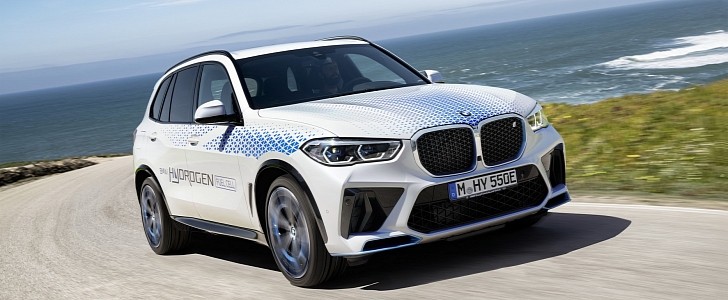Elon Musk recently said that “hydrogen is a waste of time,” but some companies are willing to spend this time to prove otherwise. Toyota already sells the Mirai, Hyundai has the Nexo, and BMW will join them by the end of 2022 with small series production of the iX5 Hydrogen. This fuel cell car will be presented at the IAA Mobility 2021 (also known as Munich Motor Show).
As the name and the images confirm, the BMW iX5 is based on the X5, but it replaced its conventional powertrain options with a fuel cell that offers an electrical output of 125 kW (168 hp, or 170 ps). Hydrogen is stored at 700 bar (10,153 psi) in CFRP (carbon-fiber-reinforced plastic) tanks that can hold up to 6 kilograms of the gas.
BMW wanted to highlight how convenient hydrogen fueling is: you’d only waste 4 to 6 minutes in the process, while you’d have to wait at least 15 minutes to fast charge an 800V electric car for much less range. Regular EVs such as Teslas, with 400V systems, take much longer than that.
The German company also said it could travel long distances but did not disclose how far the iX5 Hydrogen can go with full tanks. BMW also did not inform if the fuel cells or the hydrogen tanks made this adapted car offer less room or any other handicap compared to the regular vehicle.
What we know is that it has a fifth-generation BMW eDrive electric powertrain that would be much more efficient than previous ones. The iX5 also has a battery pack that is used to store electricity from regenerative braking. Unfortunately, BMW did not disclose how big it is or if it can be recharged, which would make it the most efficient PHEV (plug-in hybrid) the company ever created. It would also be fun, with a system output of 275 kW (369 hp, or 374 ps).
BMW wanted to highlight how convenient hydrogen fueling is: you’d only waste 4 to 6 minutes in the process, while you’d have to wait at least 15 minutes to fast charge an 800V electric car for much less range. Regular EVs such as Teslas, with 400V systems, take much longer than that.
The German company also said it could travel long distances but did not disclose how far the iX5 Hydrogen can go with full tanks. BMW also did not inform if the fuel cells or the hydrogen tanks made this adapted car offer less room or any other handicap compared to the regular vehicle.
What we know is that it has a fifth-generation BMW eDrive electric powertrain that would be much more efficient than previous ones. The iX5 also has a battery pack that is used to store electricity from regenerative braking. Unfortunately, BMW did not disclose how big it is or if it can be recharged, which would make it the most efficient PHEV (plug-in hybrid) the company ever created. It would also be fun, with a system output of 275 kW (369 hp, or 374 ps).





















